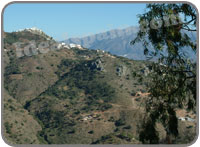Sitting high on a cliff, more than 725 metres above sea level, the beautiful village of Comares is a jewel within the Axarquia region of Andalucia. |
|
|
|
Steeped in history, Comares makes a wonderful visit and the walk around the village is pleasant and safe. There's a planned walking route, following ceramic footsteps, guiding you to the best places to see, many of which are inaccessible to traffic. The central route takes around 30 minutes to walk. |
|
|
|
Location of Comares
Comares is 35km from Malaga and just 25km from the coast. Torre del Mar is the nearest coastal town. The population is around 1,700 which includes a good population of foreign residents who have made the village their home. |
| |
What to see in Comares
The Moorish fortress, once a Roman military outpost, known as La Tahona has two turrets still remaining.
The Church of Nuestra Senora de la Encarnacion is a 16th century building in Mudejar style. |
|
|
|
|
The history of Comares
The name 'Comares' originates from the Arab word for castle, 'Qumarix'. In Nazari times it was known as Hins Qumarix, or 'High Castle'. Other sources spell the name as Comarix, Qumaris or Qumarich.
The first fortress in Comares was built by the Romans, but the history of the town is pre-Roman and the main traces of occupation are Arabic.
When the Moors invaded Comares they made full use of its excellent location and developed the town into one of Axarquia's principle defensive strongholds. During the 11th century Comares became the regional administrative headquarters of Cutar, El Borge, Almachar and Moclinejo. By the 15th century, however, Moorish rule in Spain was declining and when Velez-Málaga fell to the Christians in May 1487. The last Moslem governor of Comares, Mohammed El Jabis, paid homage to the Catholic monarchs in the hope of staving off invasion. But in late 1487 Comares fell to the Christians
|
 |

